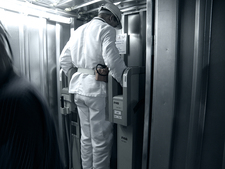Radiation protection

![]() Contamination control at the shaft exit
Contamination control at the shaft exit
Once the BfS had taken over the Asse II mine, it implemented for the first time a complete, verifiable and quality-assured radiation protection regime. To meet the legal requirements in terms of radiation protection, the BfS developed
- A radiation protection regulation
- New radiation protection instructions and
- New internal rules of undertakings.
The radiation protection regulation determines, among others, radiation protection areas and defines “potentially hazardous sites”.
For operational safety reasons the BfS has sealed the last emplacement chambers that were still open. Thus also the radiation exposure due to volatile radionuclides has reduced (in particular radon-222).

